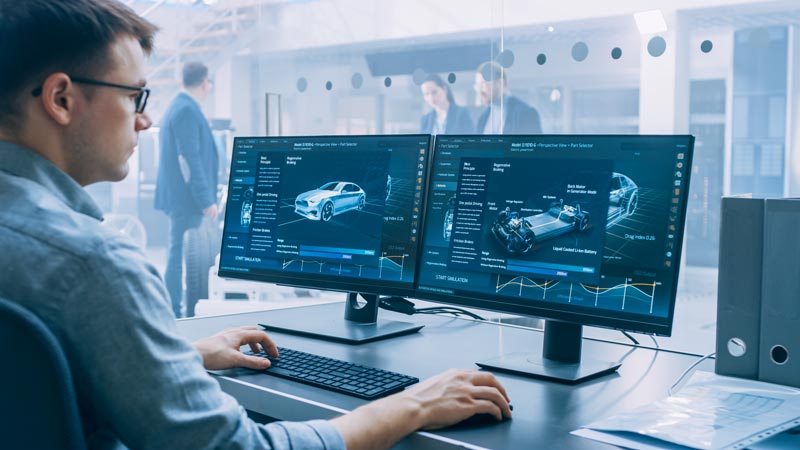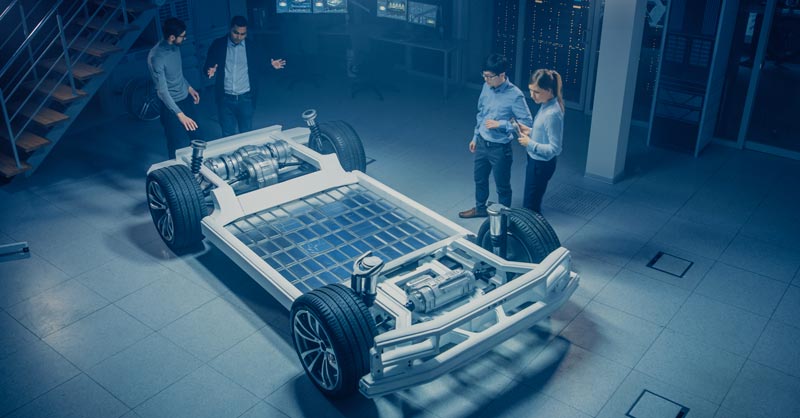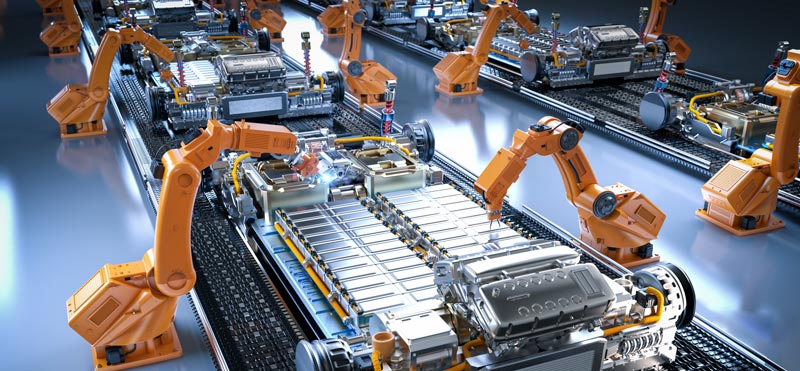The Roadmap to Electric Vehicle Manufacturing
Last updated on February 5th, 2024
The rapid growth of the electric vehicle (EV) has sparked a revolution in the automotive manufacturing industry where fast-paced processes transform ideas into tangible products that construct and power these vehicles. In this post, we delve into the journey of electric vehicle components, from initial design and prototyping phases to full production.
1. Conceptualization and design of EV components
The journey of electric vehicle components begins with the conceptualization and design phase. Engineers and designers work collaboratively to create innovative concepts for various components such as e-batteries, motors, power electronics, and charging systems. EVs require increasingly intricate electrical systems, high-voltage components, and sophisticated battery management systems. Designing and manufacturing these complex components necessitates expertise in electrical engineering, energy storage, and power electronics. Extensive research, market analysis, and performance requirements play crucial roles in shaping the design process.

Building an electric vehicle component prototype and selecting materials
Once the initial designs are developed, the next step is prototyping. Prototypes allow manufacturers to test and refine the functionality, performance, and safety of the components. Through iterative design improvements, engineers address potential issues, optimizing the new components for mass production.
Electric vehicle component prototypes are constructed using a combination of materials depending on the specific system. Common materials include steel for structural components, aluminum for weight reduction, advanced composites like carbon fiber reinforced polymer (CFRP) for high strength-to-weight ratio, plastics for non-structural parts, copper and aluminum alloys for electrical conductors, lithium-ion batteries for energy storage, automotive-grade glass for transparency, and rubber for tires and sealing.
As EV technology continues to advance, new materials and manufacturing techniques may be incorporated into prototype construction to further optimize performance, efficiency, and safety, while reducing things like noise and weight.
Selecting appropriate materials is vital for electric vehicle components. Traditional automotive components often utilize materials like steel, aluminum, and various alloys. In contrast, EV components often emphasize lightweight materials such as advanced composites and high-strength alloys to enhance efficiency and maximize range.
Manufacturing techniques like additive manufacturing (3D printing), precision machining, and automated assembly lines enable efficient production of complex components.

3. Testing and validation
Before transitioning to mass production for any complex automotive part, rigorous testing and validation procedures are conducted. The testing and validation processes for EV components may be more complex compared to traditional automotive components. Most automotive components undergo testing to ensure performance, efficiency, safety, and compliance with regulatory standards but specific testing protocols, such as battery performance and endurance tests, are unique to EV component manufacturing.
4. Scaling up for mass production
Once the prototypes have successfully undergone testing and validation, the focus shifts to scaling up for mass production. This process normally takes place in two phases. Let’s explore the new product introduction (NPI) and ramp phases in the context of an electric vehicle (EV) component, specifically an advanced electric motor.
New Product Introduction (NPI) phase of manufacturing
During the NPI phase, the focus is on transitioning the advanced electric motor design from development to production. Key activities in this phase include:
- Design for manufacturing (DFM): Evaluating the motor design to ensure it is optimized for efficient and cost-effective manufacturing. This involves assessing factors such as component selection, manufacturing processes, assembly techniques, and material choices to enhance the motor’s manufacturability.
- Process validation: Verifying and validating the manufacturing processes for the electric motor. This includes testing the assembly techniques, conducting quality inspections, and refining the manufacturing steps to ensure consistency and meet performance specifications. This phase could involve creating prototypes or small-scale production runs to refine the processes.
- Supplier qualification: Identifying and selecting suppliers for the necessary motor components and materials. This includes assessing their capabilities, quality control processes, and ability to meet volume requirements. Close collaboration with suppliers is crucial to ensure a reliable supply chain for the components.

Ramp phase of manufacturing
Once the NPI phase is complete, the focus shifts to ramping up production of the advanced electric motor. This involves gradually increasing the production volume while maintaining product quality and meeting market demand. Key activities in this phase include:
- Production capacity expansion: Adding additional manufacturing equipment, assembly lines, and personnel. This allows for higher motor production volumes and improved efficiency.
- Supply chain optimization: Streamlining the supply chain to ensure the timely availability of components and materials required for motor production. This involves working closely with suppliers to improve logistics, reduce lead times, and minimize any disruptions that could impact production.
- Continuous improvement: Implementing continuous improvement initiatives to optimize the manufacturing processes and enhance motor quality. This includes analyzing production data, gathering customer feedback, and using quality metrics to identify areas for improvement and implementing corrective actions.
- Quality assurance: Establishing robust quality control measures to ensure consistent motor performance and reliability and address any issues that may arise during the ramp-up phase. The use of a predictive quality solution is ideal at this stage to analyze new or complex factors that could be causing part quality issues, and will provide an easy way to share and visualize anomalies and causes of defects.
Throughout the NPI and ramp phases, close collaboration between engineering, manufacturing, and supply chain teams is essential to ensure a smooth transition, maintain product quality, and meet market demand for the advanced electric motor component.
Achieving stable production in electric vehicle manufacturing
Reaching stable production in manufacturing is of paramount importance for electric vehicle (EV) component manufacturers for many reasons. Firstly, it enables manufacturers to meet the increasing market demand for EVs efficiently. The new edition of the IEA’s annual Global Electric Vehicle Outlook shows that more than 10 million electric cars were sold worldwide in 2022 and that sales are expected to grow by another 35% this year to reach 14 million.
When they reach stable production of a newly introduced component, manufacturers can ensure a consistent and reliable supply of parts, enabling automakers to produce EVs in larger quantities and meet customer expectations regarding availability and delivery timelines.
Stable production also plays a crucial role in optimizing costs and improving profitability. Manufacturers can benefit from economies of scale, streamline production processes, and reduce per-unit costs. This cost optimization makes EV components more affordable, attracting a broader customer base and enhancing market competitiveness.
Once production has stabilized, it allows manufacturers to focus on continuous improvements and technological advancements. Manufacturers can dedicate resources to research and development, innovation, and the integration of new technologies. This promotes the evolution of EV components, driving advancements in efficiency, performance, and functionality.
While stable production is the goal, there are some challenges in achieving it for EV component production.

Barriers to stabilizing production
Electric vehicle (EV) components are generally more challenging to manufacture compared to traditional vehicle components. Firstly, the electrification of vehicles introduces new technologies, materials, and manufacturing processes that require specialized expertise and infrastructure. For example, EV components such as batteries and power electronics involve advanced electrical systems, energy storage technologies, and precise control mechanisms. The manufacturing of these components demands a deep understanding of electrical engineering principles, specialized production techniques, and stringent quality control measures.
EV components often face higher performance demands and safety considerations compared to traditional vehicle components. Electric motors, for instance, require precise manufacturing tolerances to achieve optimal efficiency and torque delivery. Battery packs need meticulous assembly processes to ensure thermal management, cell balancing, and safety features. The integration of sophisticated control systems, connectivity features, and charging infrastructure also adds complexity to EV component manufacturing.
Roadblocks that can be encountered on the way to stable production are:
- Manufacturing complexities: The complexity of the components can lead to issues in maintaining consistent quality, efficiency, and reliability while trying to manage specialized materials and delicate processes
- Supply chain constraints: Coordinating and managing the supply chain for electric vehicle components can be challenging due to the need for specific materials, tight tolerances, and high volumes.
- Technological advancements: The standard production processes for these components may still be in development or optimization stages. Implementing novel technologies into stable production can require time for research, testing, and refinement.
- Meeting safety standards: Establishing robust safety testing procedures is essential but can be a time-consuming and iterative process. Adhering to these safety standards can result in production delays until all requirements are met.
- Cost optimization: Electric vehicle components often have high production costs due to specialized materials, manufacturing techniques, and low economies of scale. The pursuit of cost optimization while maintaining stability can take time and effort.
Manufacturers and industry stakeholders work diligently to overcome these challenges and achieve stable production to meet the growing demand for electric vehicles. Using reliable predictive quality software and ensuring good communication between design, quality and engineering teams can go a long way to ensuring that new products reach stable production as quickly as possible.

Share on social: